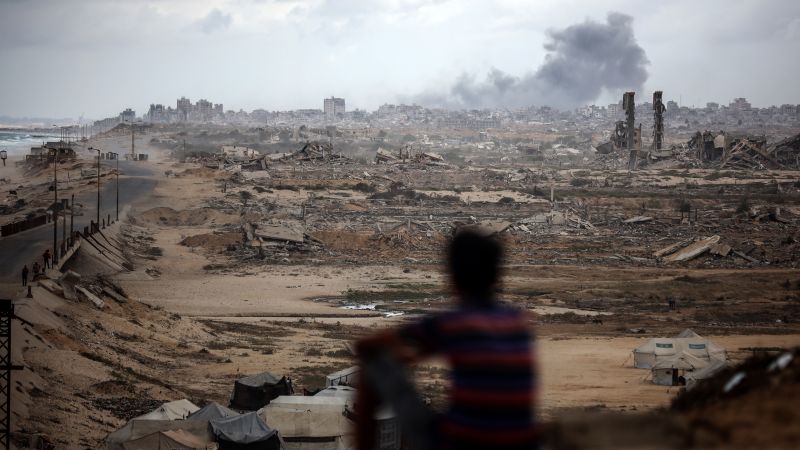
After months of delays and disappointments, US President Donald Trump announced that Israel and Hamas have agreed to the first phase of his plan for peace in Gaza.
Although Trump’s short post on Truth Social represented a major diplomatic breakthrough, it leaves much to be decided.
A ceasefire could come into effect as soon as Friday and Israeli hostages could be released early next week, but it is not clear whether Israel and Hamas will agree to other conditions proposed by Trump relating to thornier questions of what Gaza will look like after the war.
Here’s what we know about the deal so far.
What has been agreed?
The US president broke news of an agreement on his Truth Social platform on Wednesday, saying it would lead to the swift release of hostages and the withdrawal of Israeli forces to an agreed line.
“This is a GREAT Day for the Arab and Muslim World, Israel, all surrounding Nations, and the United States of America, and we thank the mediators from Qatar, Egypt, and Turkey, who worked with us to make this Historic and Unprecedented Event happen. BLESSED ARE THE PEACEMAKERS!”
Israeli Prime Minister Benjamin Netanyahu will convene a meeting of his security cabinet on Thursday to vote on the agreement. Once the agreement is approved, a ceasefire in Gaza will begin, two Israeli officials told CNN.
With a ceasefire in place, Israeli forces will begin their partial withdrawal from Gaza, expected to take less than 24 hours. Following that, Hamas will have 72 hours to release the hostages, the officials added.
There are 20 hostages who are believed to be alive, with grave concerns for the well-being of two of them. A further 28 hostages are deceased and CNN previously reported Hamas may not be able to find them all.
Osama Hamdan, a senior Hamas official, said that 250 Palestinian prisoners serving life sentences will also be released, along with 1,700 others held in Israeli jails.
But an Israeli source familiar with the matter said negotiating teams are still working on the list of prisoners to be released, and that the issue “has not yet been resolved.” The source said that any prisoner convicted of murder would not be released to the occupied West Bank, but that their transfer to a third country had not yet been determined.
Marwan Barghouti, the Palestinian political leader who has been imprisoned by Israel since 2002, will not be released, the Israeli government spokesperson said.
What is still unknown?
Even if the ceasefire takes effect and Israeli hostages and Palestinian prisoners are released, the warring parties have not agreed to major sticking points tackled in Trump’s more comprehensive 20-point plan released last month.
• Disarmament: Trump’s plan called for Hamas to “commit to peaceful co-existence” with Israel and lay down its arms, placing all weapons into an amnesty. Disarmament has long been a red line for the militant group.
• Post-war governance: The plan also called for a temporary transitional government to be established in Gaza, comprising a “technocratic, apolitical Palestinian committee” made up of “qualified Palestinians and international experts” and supervised by “a new international transitional body” called the Board of Peace.
Trump appeared to reference this board during an interview with Fox News on Thursday, saying that his administration was “forming a council of peace” to maintain a lasting end to the conflict in the region.
But it is not yet known which individuals will be appointed to these bodies, nor how it will exercise authority over Gaza.
• Israeli withdrawal: Trump’s plan also called for the creation of an “International Stabilization Force (ISF)” to be deployed to Gaza and train “vetted Palestinian police forces” in Gaza. With this force in place, the Israel Defense Forces (IDF) would then be expected to withdraw from Gaza. Israel has not yet agreed to these provisions.
• Security guarantees: Hamas has long sought concrete assurances that Israel will not resume the war once it ends, pointing to how Israel shattered the last ceasefire agreement in March. If Hamas agrees to disarm, it is likely to demand even more robust security guarantees, which it is not clear if Israel will agree to.
What comes next?
If the ceasefire holds and Israel withdraws to the agreed-upon line in Gaza, the hostages could be released Monday.
Whereas previous ceasefires have seen small groups of hostages released each week, Trump has insisted that all hostages are released at once.
Netanyahu’s cabinet meeting will only discuss the first phase of the ceasefire deal, and not Trump’s full framework, according to an Israeli source.
Implementing the full framework of Trump’s plan would likely spark a revolt among the hardline members of Netanyahu’s coalition. Itamar Ben-Gvir and Bezalel Smotrich, two far-right ministers, say Trump’s plan represents a defeat for Israel, and could threaten government stability if the peace plan progresses.
Meanwhile, Trump told Axios reporter and CNN analyst Barak Ravid that he plans to travel to Israel in the coming days. “They want me to give a speech at the Knesset,” he said.